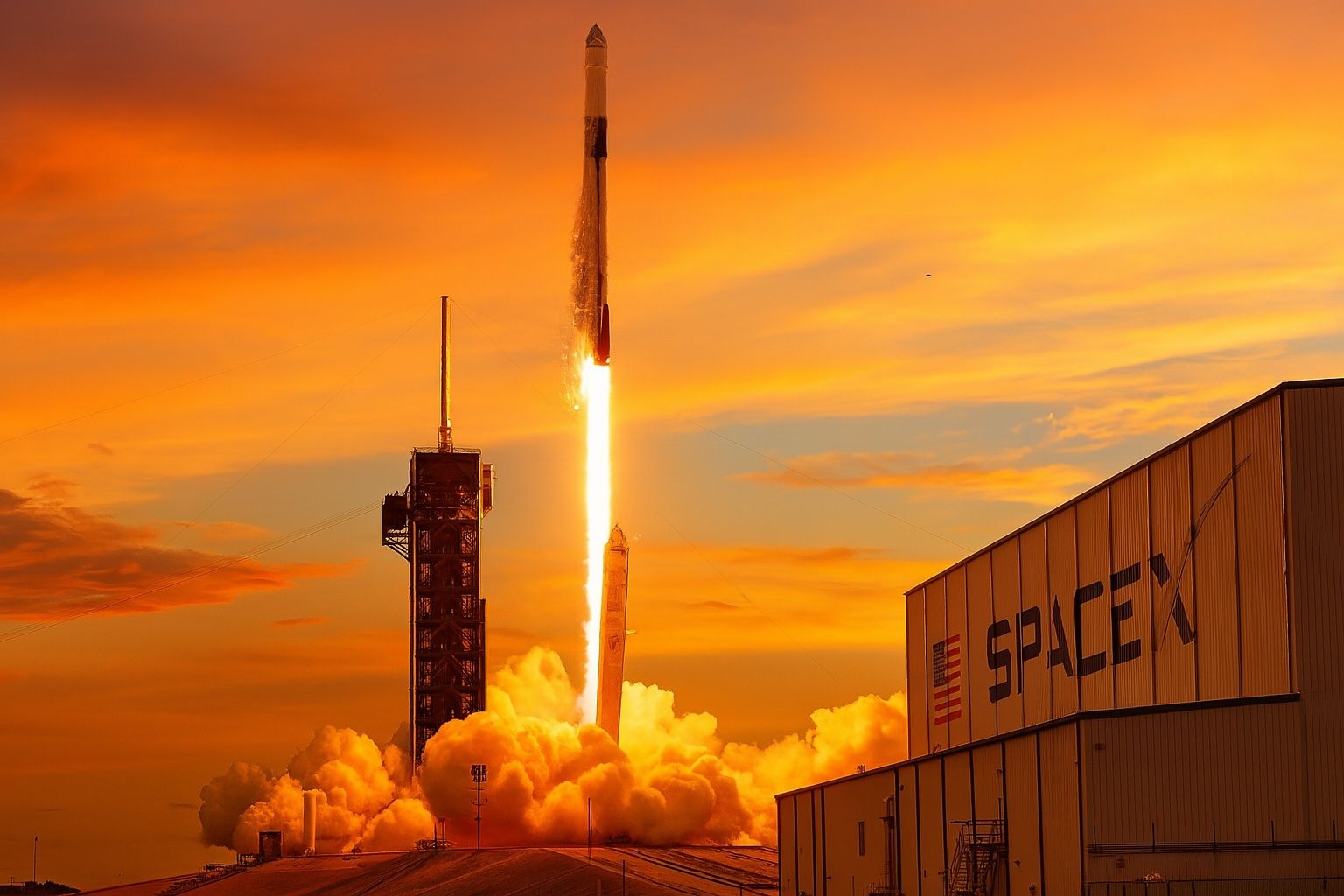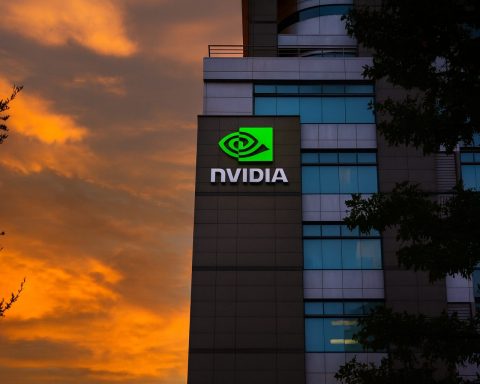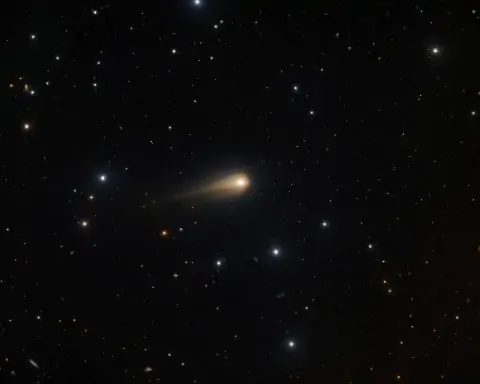- Japan’s H-2A rocket completed its 50th and final mission on June 28 (US time), launching the GOSAT-GW (“Ibuki”) greenhouse gases and water-cycle satellite into a sun-synchronous orbit with an official 98% reliability rate for the H-2A family.
- Blue Origin’s New Shepard NS-33 flight from Launch Site One in West Texas on June 29 carried six space tourists, including a husband-and-wife team, with Carl Kuehner becoming the 750th person in space.
- SpaceX conducted a rapid-fire Falcon 9 doubleheader—one launch from Cape Canaveral just after midnight on June 28 and a second from Vandenberg 13 hours later—deploying dozens of Starlink satellites and extending the company’s streak to over 200 consecutive successful Falcon 9 flights, with a roughly 2.4-day pad turnaround on the Florida mission.
- Rocket Lab launched two Electron rockets within 48 hours from New Zealand’s Launch Complex 1, placing a small undisclosed commercial satellite on June 28 (NZ time) after a HawkEye 360 mission two days earlier, achieving a sub-2-day turnaround and bringing Rocket Lab to four Electron missions in June.
- NASA’s Curiosity rover found first close-up “boxwork” rock formations in Gale Crater, Mars, with lattice-like ridges up to about 20 kilometers long indicating ancient groundwater involvement.
- The Mars Reconnaissance Orbiter performed extreme 120-degree belly-up rolls in 2023–24 to invert the SHARAD radar, boosting signal strength tenfold and enabling detection of subsurface water ice and layering far beneath the Martian surface.
- NASA’s James Webb Space Telescope directly imaged a Saturn-mass exoplanet, designated TWA 7b, orbiting a star 110 light-years away, marking the least massive planet yet seen by direct imaging.
- Astronomers captured the first direct image of the cosmic web—the network of intergalactic hydrogen gas filaments—using a distant quasar’s light to illuminate the filaments, confirming a key prediction about large-scale structure.
- A Northrop Grumman BOLE solid rocket booster for NASA’s Space Launch System suffered a nozzle blow-off during a full-scale static fire test, triggering an investigation and signaling a possible redesign before Artemis missions.
- At the Artemis Accords update gathering, officials highlighted more than 30 signatories with Brazil and Türkiye near joining, while the EU advanced its space policy and a U.S.–Sweden Technology Safeguards Agreement was signed to allow American rockets to launch from Swedish soil.
Satellite Launches and Deployment
It has been an exceptionally busy period for orbital launches around the globe. Japan’s H-2A rocket flew its 50th and final mission, drawing the curtain on a 24-year career. The liquid-fueled H-2A, developed by Mitsubishi Heavy Industries and JAXA, successfully lofted an Earth-observation satellit into a sun-synchronous orbit on June 28 (US time) [1] [2]. The payload, nicknamed GOSAT-GW (“Ibuki” Greenhouse Gases and Water Cycle), will monitor greenhouse gas levels and the water cycle from space [3]. Crowds of onlookers in Tanegashima cheered the nighttime launch, which achieved a long-held reliability goal of 98% success for the H-2A series [4]. “I was more nervous than ever about the launch… We achieved our long-cherished goal of a 98 percent success rate,” said Mitsubishi launch director Keiji Suzuki as Japan shifts to the newer H3 rocket going forward [5]. The final H-2A flight was one of four orbital launches within 13 hours on June 28, bookended by other commercial missions [6].
Blue Origin’s New Shepard rocket lifts off from West Texas on June 29, 2025, carrying six space tourists on a 10-minute suborbital flight (Image credit: Blue Origin).
Blue Origin notched a space tourism milestone this weekend, launching its 13th crewed suborbital flight and sending its 70th person to space [7]. The New Shepard rocket lifted off from Launch Site One in West Texas at 9:40 a.m. local time on June 29 with six private passengers, including a husband-and-wife duo, on a 10-minute flight past the Kármán line [8]. One rider, Carl Kuehner, officially became the 750th human in history to reach space, according to the Association of Space Explorers’ registry [9]. The reusable booster landed safely and the crew capsule, RSS Kármán Line, parachuted back to Earth, delivering all six spacefarers smoothly back after a few minutes of weightlessness [10] [11]. This NS-33 mission proceeded “to plan,” with Blue Origin’s Club for the Future also flying 1,000+ student-designed postcards alongside the crew as part of an educational outreach program [12].
SpaceX extended its record-breaking launch cadence, completing a rapid-fire doubleheader of Starlink launches from two coasts. On June 28, a Falcon 9 lifted off just after midnight from Florida’s Cape Canaveral, and within 13 hours another Falcon 9 launched from Vandenberg Space Force Base in California [13]. Together these missions deployed dozens of Starlink internet satellites to orbit. Notably, the Florida launch set a new turnaround record for reusing the same pad, coming roughly 2.4 days after the pad’s previous mission – a testament to SpaceX’s fast refurbishment and launch workflow. The company’s ability to launch two orbital missions in half a day underscores the frenetic pace of its satellite deployment program. SpaceX also grabbed headlines by sharing stunning imagery of Starlink satellite deployments, with onboard cameras capturing a “train” of satellites gleaming against Earth’s backdrop in space.
Rocket Lab joined the fray by launching two Electron rockets within 48 hours, marking its fourth launch in a single month [14] [15]. On June 28 (New Zealand time), an Electron rocket from Mahia Peninsula successfully placed a small undisclosed commercial satellite into orbit [16]. Just two days earlier, Rocket Lab had launched another mission carrying a cluster of HawkEye 360 radio-frequency surveillance microsatellites [17]. Achieving a sub-2-day turnaround between missions from the same launch site is a record for Rocket Lab, demonstrating a responsive launch capability. These back-to-back successes show how smaller launch providers are increasing the tempo of satellite deployments alongside industry giants.
Space Exploration (Moon, Mars and Beyond)
A mosaic of new Curiosity rover images shows crisscrossing “boxwork” mineral ridges on Mars, which look like giant spiderwebs from orbit (Credit: NASA/JPL-Caltech/MSSS via Live Science).
On Mars, NASA’s Curiosity rover has beamed back the first close-up views of peculiar “spiderweb” rock formations, offering “dramatic evidence” of the Red Planet’s watery past [18] [19]. The rover reached a region of Gale Crater laced with hardened, lattice-like ridges – known as boxwork – that span up to 20 km and were previously seen only from orbit [20] [21]. Smaller boxwork features on Earth form when mineral-rich groundwater percolates through cracks in bedrock, leaving cemented veins that resist erosion. Curiosity’s discovery suggests a similar process occurred on Mars long ago. As NASA explained, “groundwater trickling through the rock left behind minerals… Eons of sandblasting by Martian wind wore away the rock but not the minerals, revealing networks of resistant ridges” [22]. These giant mineral webs are a compelling clue that liquid water persisted under Mars’ surface for extended periods, potentially creating habitable subsurface environments in the planet’s ancient past [23] [24]. Scientists are excited to study why this boxwork appears only in one area of Mount Sharp and what it reveals about Mars’ environmental history.
Meanwhile high above Mars, the veteran Mars Reconnaissance Orbiter (MRO) is literally rolling out new tricks after nearly two decades in service. NASA engineers tested a bold maneuver involving “very large rolls” of the spacecraft – up to 120° – to dramatically improve the performance of MRO’s subsurface radar instrument SHARAD [25] [26]. Normally, MRO rolls up to 30° to aim its science instruments, but by flipping the orbiter belly-up, the team found SHARAD’s ground-penetrating radar signal strength increased tenfold [27] [28]. This deeper peering ability opens “entirely new regions of the subsurface to explore,” said PSI senior scientist Gareth Morgan, “proving you can teach an old spacecraft new tricks” [29]. Three such extreme rolls were executed in 2023-24 as proof of concept [30]. The payoff is significant: with the spacecraft inverted, SHARAD gets an unobstructed view, enabling it to detect water ice and geologic layering far beneath Mars’ surface that were previously out of reach [31] [32]. This innovative sleight-of-hand by MRO may guide future explorers to buried ice deposits useful for life support and fuel on Mars. It’s a remarkable extension of capabilities for a probe in its 19th year at the Red Planet.
In lunar exploration, NASA’s Artemis program encountered a hiccup during testing of a next-generation Space Launch System (SLS) solid rocket booster. A full-scale static fire test of Northrop Grumman’s new BOLE booster, intended for future Artemis moon missions, ended with a bang: the booster’s nozzle unexpectedly blew off mid-test, engulfing the Utah test stand in flames [33]. Dramatic video showed the aft nozzle piece separating under pressure, though the motor kept firing for some seconds afterward [34] [35]. The anomaly is under investigation, and Northrop says it tested the “most powerful segmented solid rocket booster ever built” [36]. This upgraded booster design aims to increase Artemis launch performance, but engineers will now need to determine what went wrong and likely redesign the nozzle fixture [37]. NASA officials noted that’s the purpose of ground tests – to find and fix issues before flight. Although a setback, the data from the test will be used to improve the boosters that could one day propel astronauts toward the Moon and beyond. NASA’s SLS schedule has some margin, but any significant redesign could potentially impact the timeline for Artemis V and subsequent lunar missions if not resolved swiftly.
Beyond the Moon and Mars, space telescopes are expanding our cosmic horizons with breakthrough observations. NASA’s James Webb Space Telescope (JWST) achieved a historic first by directly discovering a new exoplanet — something no previous space telescope had done. The youthful gas giant, about the mass of Saturn, orbits a star 110 light-years away and is now the least massive planet ever imaged directly [38] [39]. Fewer than 2% of known exoplanets have been seen via direct imaging (most are found by indirect methods), highlighting Webb’s impressive capability [40]. “Webb opens a new window… to exoplanets that had not been accessible to observations so far,” said astronomer Anne-Marie Lagrange, lead author on the discovery study [41]. The planet, designated TWA 7b, appears in Webb’s mid-infrared images as a faint dot amid the glare of its star – made possible by Webb’s advanced coronagraph that blocks starlight [42]. Scientists say capturing this Saturn-mass world, at a wide orbital distance, “is important to explore the diversity of exoplanetary systems and understand how they form and evolve” [43]. The finding demonstrates JWST’s potential to directly observe even smaller, colder exoplanets in the future, inching closer to imaging an Earth-like world. Webb’s exoplanet feat comes on top of its ongoing studies of the early universe and spectacular views of known exoplanets’ atmospheres.
Astronomers also announced a triumph in observational cosmology: for the first time, they captured a direct image of the cosmic web – the vast network of diffuse gas filaments and dark matter connecting galaxies across the universe. Using a distant quasar’s light as illumination, a team was able to detect a faint glow from intergalactic hydrogen gas tracing the web’s filaments. These “hidden highways of the Universe” had been predicted by simulations but never seen until now [44]. The ghostly image confirms that galaxies are not isolated islands but nodes in a gigantic cosmic filament network. Seeing the cosmic web directly will help cosmologists understand how galaxies formed and clustered along these filaments in the early universe [45]. This breakthrough follows other cutting-edge space observations, from Chandra X-ray telescope’s new high-resolution portrait of Andromeda Galaxy to the identification of the largest-known structure in the universe (a 3 billion light-year-wide galaxy supercluster) [46] [47]. Together, these discoveries underscore a golden age of space science, with advanced telescopes providing unprecedented insight into both the earliest times and the grand-scale structure of the cosmos.
Space Industry Developments (SpaceX, Blue Origin, & More)
Innovation and competition in the space industry continue at a rapid clip. SpaceX has secured a major U.S. military launch contract, further cementing its dominance in the launch market. The U.S. Space Force awarded SpaceX an $81.6 million deal to launch a next-generation weather satellite in 2027 [48]. This mission – the third competitive National Security Space Launch (NSSL) Phase 3 task order in a row that SpaceX has won – will carry the Weather System Follow-on – Microwave (WSF-M) satellite to orbit. SpaceX’s bid significantly undercut competitor ULA’s prices, reflecting the cost savings of its reusable Falcon 9 rockets [49] [50]. The Space Force contract highlights how SpaceX’s reliability and low-cost cadence are reshaping government launch procurement. In fact, Pentagon officials are even studying alternatives to ensure competition, as SpaceX’s launch tempo threatens to leave rivals behind [51]. In addition to the new contract, SpaceX this week celebrated surpassing 200 successful Falcon 9 flights in a row, an unprecedented streak that speaks to the maturity of its workhorse rocket.
Blue Origin’s space tourism business achieved a noteworthy record, as discussed above, by flying the 750th person to space on its latest New Shepard launch. The company is steadily increasing the frequency of its suborbital trips for paying customers and researchers. With 13 crewed flights now complete, Blue Origin has safely lofted a diverse group of private astronauts, from schoolteachers to celebrities, and even some repeat fliers. The success of the June 29 flight signals growing public interest in commercial human spaceflight, and Blue Origin is expected to ramp up its launch schedule further if demand holds. Founder Jeff Bezos has indicated the goal is to make access to space more routine, and hitting milestones like 70 individual people flown is a step toward that vision [52]. Blue Origin is also making progress on its next big project – the orbital-class New Glenn rocket – although its first flight is now anticipated in 2026 after some delays. In the meantime, New Shepard’s string of flights is providing valuable experience in operations and capsule reuse. Industry analysts note that Blue Origin and Virgin Galactic (which recently resumed suborbital spaceflights too) are together opening a new market for space tourism, even as they face challenges of scaling up launches while maintaining safety.
Rocket Lab’s rapid-launch achievements this week signal its emergence as a nimble player in the smallsat launch sector. By turning around two missions in two days, Rocket Lab demonstrated responsive launch capability that could appeal to commercial constellation operators and government customers needing quick access to orbit. The company used two different pads at its New Zealand Launch Complex 1 to enable the swift cadence, launching the second Electron less than 48 hours after the prior mission’s liftoff [53]. CEO Peter Beck lauded his team for the feat, highlighting that flexible scheduling and streamlined operations made it possible. With the successful deployment of customers’ satellites (including the HawkEye 360 Pathfinder spacecraft and others), Rocket Lab has now launched four missions in one month – a record for them [54]. This puts Rocket Lab on pace to greatly exceed its launch total from last year and shows it can handle higher volume. The company is also preparing the debut of its larger Neutron rocket in the coming year, aiming to compete in the medium-lift market currently dominated by SpaceX’s Falcon 9.
Several startups and international ventures reported mixed results. Europe’s The Exploration Company announced a “partial success” for its “Mission Possible” reentry capsule test, which flew to space on a rideshare and attempted a controlled reentry and ocean splashdown [55]. The prototype capsule did reach orbit, but contact was lost during reentry, and it crashed into the Atlantic – resulting in the loss of some aboard payloads, including a batch of commemorative human ashes and experimental cannabis seeds meant for a space biology study [56] [57]. “Families [received] an unpleasant surprise” as the memorial remains they paid to send to space were lost at sea [58] [59]. The incident underscores the risks of burgeoning space memorial and biotech services, though The Exploration Company stressed that much of the mission’s objectives were achieved and lessons learned will inform their next capsule iteration. On a more positive note, Firefly Aerospace and the Swedish Space Corporation finalized a technology safeguard agreement enabling Firefly’s Alpha rocket to launch from Sweden’s Esrange Spaceport in the near future [60]. This U.S.-Sweden partnership opens the door for the first orbital launches from mainland Europe, showcasing increased international collaboration in commercial launch operations. In the satellite manufacturing arena, startups continue to innovate in miniaturized spacecraft and high-speed communications; for instance, Moog unveiled a new high-speed space computer to support advanced onboard AI processing [61]. Across the industry, investment in space startups remains brisk in 2025, but investors are also watching cost-cutting moves – one notable case being Terran Orbital’s shift to a 4-day workweek to improve efficiency and reduce burnout for its satellite production staff [62]. All told, the commercial space sector is hitting new milestones but also facing the realities of scaling complex technologies from test flights to reliable services.
Technological Advancements in Space
Cutting-edge technology is propelling current and future space missions, even as engineers grapple with occasional glitches. In the realm of launch propulsion, aside from the SLS booster anomaly noted earlier, SpaceX’s rocket reusability continues to advance. The latest Falcon 9 missions featured boosters flying for their 14th and 15th times, nearing the company’s nominal 20-flight reuse target. SpaceX is also test-firing engines for its Starship program at a rapid pace in Texas, trialing design tweaks to the Raptor engines and launch pad systems after April’s orbital test flight. Elon Musk stated that the next Starship launch attempt, carrying upgrades to mitigate pad damage and engine reliability, could occur later in 2025 pending FAA approval. If successful, Starship will significantly boost payload capacity and further reduce launch costs – a key tech enabler for SpaceX’s ambitions on Mars and the Moon.
Advances in spacecraft autonomy and AI were highlighted during the week as well. NASA officials noted that the autonomy software on the Perseverance Mars rover has been instrumental in speeding up science operations – the rover’s AI-driven navigation allows it to drive farther each Martian day while avoiding hazards, and onboard algorithms prioritize interesting rock samples for the team. In Earth orbit, satellite operators are increasingly deploying AI for real-time data processing, such as filtering useful observations from imaging satellites before downlink to save bandwidth. One example is ESA’s Φ-sat-2 experimental AI satellite, which uses machine learning to analyze images on-orbit. These incremental but important tech advancements are making missions more efficient and data-rich.
Astronomers are also benefiting from new hardware breakthroughs. The Vera C. Rubin Observatory in Chile, home to the world’s largest digital camera at 3.2 gigapixels, released its first test images this week [63]. The images of a starfield, although just a trial run, demonstrate the observatory’s ability to survey vast swaths of sky in incredible detail. Once fully operational in 2025, Rubin’s Legacy Survey of Space and Time (LSST) camera will scan the entire southern sky repeatedly, enabling discoveries of transient events, near-Earth asteroids, and the mysterious dark matter structure of the universe [64] [65]. Scientists are excited by the camera’s performance so far – one early image resolved tens of thousands of distant galaxies in a single shot. However, Rubin Observatory’s team is also raising alarms about potential budget cuts that could slow the survey cadence [66]. They argue that investing in such breakthrough technology will pay dividends in scientific returns for years to come.
Another forward-looking development came in the field of gravitational wave detection. Physicists unveiled a concept using powerful superconducting magnets and cryogenic sensors to potentially detect high-frequency gravitational waves – elusive ripples in spacetime that current detectors like LIGO cannot hear [67]. If successful, this technology could open a new window on astrophysical phenomena such as primordial black holes or cosmic string vibrations. It’s a reminder that space technology isn’t only rockets and satellites, but also ground-based innovations that expand our understanding of the universe.
Finally, in satellite operations, engineers are tackling the challenge of orbital debris with new tech. Companies are testing active debris removal spacecraft equipped with robotic arms or nets to capture defunct satellites. One consortium in Europe announced it will launch a demonstration of a “space janitor” craft in late 2025 to grab a drifting piece of junk and safely de-orbit it. Meanwhile, insurers are voicing concern over a spate of recent satellites breaking up in orbit, from battery explosions to fuel tank ruptures, which are not covered by standard policies [68]. This is spurring interest in technology to passivate spent satellites (vent leftover fuel and drain batteries) and in improved space traffic monitoring via AI. All these efforts underscore that as humanity’s use of space grows, so too must our technology to use space sustainably and safely.
Space Policy and International Cooperation
Debates over space policy, budgets, and cooperation have been front and center. In the United States, NASA’s future funding is under intense scrutiny, with the agency caught in political crosswinds. The new administration in Washington has proposed deep cuts to several NASA programs as part of broader budget reductions. Former NASA leadership has issued stark warnings about the impact. “The space agency is being savaged,” cautioned ex-NASA Administrator Bill Nelson in response to the Trump White House’s proposed cuts [69]. Nelson, who served as NASA chief until earlier this year, penned an op-ed arguing that slashing NASA’s planetary exploration and science missions not only jeopardizes American leadership in space but also “forgets national security” implications [70] [71]. According to reports, the White House budget office has targeted a dozen missions for termination – ranging from a Venus probe and an Earth climate satellite to a planned Europa lander – in an effort to trim costs [72]. These proposals have been met with pushback in Congress and the scientific community, which note that many of these missions were decades in the making. Lawmakers from both parties have signaled support for restoring key programs, setting the stage for budget negotiations that will determine NASA’s direction. In the meantime, NASA has instituted a temporary hiring freeze and offered “voluntary workforce shaping” (buyouts) to employees [73] [74], preparing for possible leaner times ahead.
While NASA battles for funding, the U.S. Space Force appears poised for a major boost. A draft defense budget bill moving through Congress – touted by President Trump as “One Big, Beautiful Bill” – would authorize nearly $40 billion for the Space Force, a substantial increase aimed at expanding military space capabilities [75]. This includes funding for new GPS and missile-warning satellites, advanced launch services, and the development of space-based surveillance and anti-jamming technology. The hefty investment underscores the strategic importance the U.S. places on dominating the high ground of space, even as it contrasts with the constraints proposed for NASA’s civilian efforts. Critics of the NASA cuts point out the irony that space science is being trimmed while military space spending grows unabated. However, proponents in the administration argue that the private sector can take on more of NASA’s workload (citing companies like SpaceX and Blue Origin) and that defense should be the priority for government dollars. The final outcome will depend on budget negotiations in the coming months, but clearly the balance of public space spending in America is at a crossroads.
On the international stage, global cooperation in space continues to deepen, even amid geopolitical tensions on Earth. Officials from over two dozen countries convened virtually this week to discuss updates to the Artemis Accords, the U.S.-led framework for responsible lunar exploration. Brazil and Türkiye are reportedly close to signing on, which would bring the number of Artemis Accord signatories to 30+, reflecting widespread support for common principles on things like transparency, interoperability, and safe zones on the Moon. NASA Administrator designate (pending Senate approval) Pam Melroy spoke at the meeting, emphasizing that “no nation can go alone” to the Moon sustainably, and highlighting planned contributions from Europe (ESA’s service module), Japan (lunar lander tech), and Canada (robotic arms) to the Artemis program. Notably absent were China and Russia, who are pursuing their own joint lunar base plan – though China did make news by inviting international partners to participate in its Tiangong space station and upcoming Chang’e-8 lunar mission. Western analysts view this as Beijing’s attempt to offer an alternative cooperation model, albeit one with far fewer takers to date than Artemis.
Important strides were made in bilateral and commercial space agreements. As mentioned, the U.S. and Sweden signed a Technology Safeguards Agreement enabling American rockets (like Firefly’s) to launch from Swedish territory – a move that strengthens transatlantic cooperation in the space industry [76]. In Asia, India and Japan held talks on expanding collaboration between ISRO and JAXA, particularly on India’s upcoming Gaganyaan crewed mission and possible joint work on lunar rover technology. The European Union advanced its own space policy efforts, with the EU Parliament passing new regulations to streamline space traffic management and provide funding for Europe’s planned secure satellite communications constellation (IRIS²). These policies aim to keep Europe competitive and secure in an era when SpaceX’s Starlink and China’s SatNet megaconstellations are rapidly filling the skies.
Issues of space safety and sustainability also featured prominently in policy discussions. The U.N. Committee on Peaceful Uses of Outer Space (COPUOS) met in Vienna and reached a consensus on guidelines for mitigating orbital debris, urging member states to adopt stricter 5-year post-mission disposal plans (versus the current 25-year guideline). There is growing international pressure to address the worsening debris environment as satellite collisions and fragmentations mount – insurance industry representatives at COPUOS noted that some recent satellite break-ups in orbit were not covered by insurance, highlighting an economic risk to operators [77]. Additionally, a new working group was established to discuss norms of behavior for military activities in space, an effort prompted by concerns over anti-satellite weapon tests in recent years. Space diplomats say that while a binding treaty on space arms control remains distant, incremental steps like voluntary norms could reduce misunderstandings and build trust among spacefaring nations.
In summary, June 29, 2025 has been a remarkably eventful day in space news, reflecting the full spectrum of human endeavors beyond Earth. From rockets old and new launching satellites and people, to rovers and orbiters uncovering Mars’ secrets, to powerful telescopes gazing at exoplanets and the cosmic web, and industry forging ahead amidst policy battles – the progress of space exploration and utilization shows no signs of slowing. Each accomplishment and challenge reported today – whether scientific, technical, commercial or diplomatic – plays a part in shaping the future of humanity’s journey in space. As we close out this day’s roundup, one thing is clear: space remains the arena of grand ambitions and global interest, and every day brings new milestones in our quest to understand and expand the final frontier [78] [79].
Sources: The information in this report is drawn from the latest space news updates and credible sources, including SpaceNews [80] [81], Space.com [82] [83], Live Science [84], Reuters [85], Kyodo News [86] [87], and official statements from space agencies (NASA, JAXA, ESA) [88] [89], among others. Each development above is linked to its source for further reading and verification.
References
1. spacenews.com, 2. spacenews.com, 3. spacenews.com, 4. english.kyodonews.net, 5. english.kyodonews.net, 6. spacenews.com, 7. www.space.com, 8. www.space.com, 9. www.space.com, 10. www.space.com, 11. www.space.com, 12. www.space.com, 13. spacenews.com, 14. spacenews.com, 15. spacenews.com, 16. spacenews.com, 17. spacenews.com, 18. www.cbsnews.com, 19. www.livescience.com, 20. www.livescience.com, 21. www.livescience.com, 22. www.livescience.com, 23. www.livescience.com, 24. www.livescience.com, 25. www.psi.edu, 26. www.psi.edu, 27. www.psi.edu, 28. www.psi.edu, 29. www.psi.edu, 30. www.psi.edu, 31. www.psi.edu, 32. www.psi.edu, 33. news.google.com, 34. news.google.com, 35. news.google.com, 36. news.google.com, 37. news.google.com, 38. www.reuters.com, 39. www.reuters.com, 40. www.reuters.com, 41. www.reuters.com, 42. www.reuters.com, 43. www.reuters.com, 44. news.google.com, 45. news.google.com, 46. news.google.com, 47. news.google.com, 48. www.copernical.com, 49. ts2.tech, 50. x.com, 51. spacenews.com, 52. www.space.com, 53. spacenews.com, 54. spacenews.com, 55. news.google.com, 56. news.google.com, 57. news.google.com, 58. news.google.com, 59. news.google.com, 60. spacenews.com, 61. spacenews.com, 62. spacenews.com, 63. news.google.com, 64. news.google.com, 65. spacenews.com, 66. news.google.com, 67. news.google.com, 68. news.google.com, 69. www.newsweek.com, 70. news.google.com, 71. www.newsweek.com, 72. www.forbes.com, 73. news.google.com, 74. news.google.com, 75. spacenews.com, 76. spacenews.com, 77. news.google.com, 78. spacenews.com, 79. news.google.com, 80. spacenews.com, 81. spacenews.com, 82. www.space.com, 83. www.space.com, 84. www.livescience.com, 85. www.reuters.com, 86. english.kyodonews.net, 87. english.kyodonews.net, 88. www.psi.edu, 89. www.copernical.com









